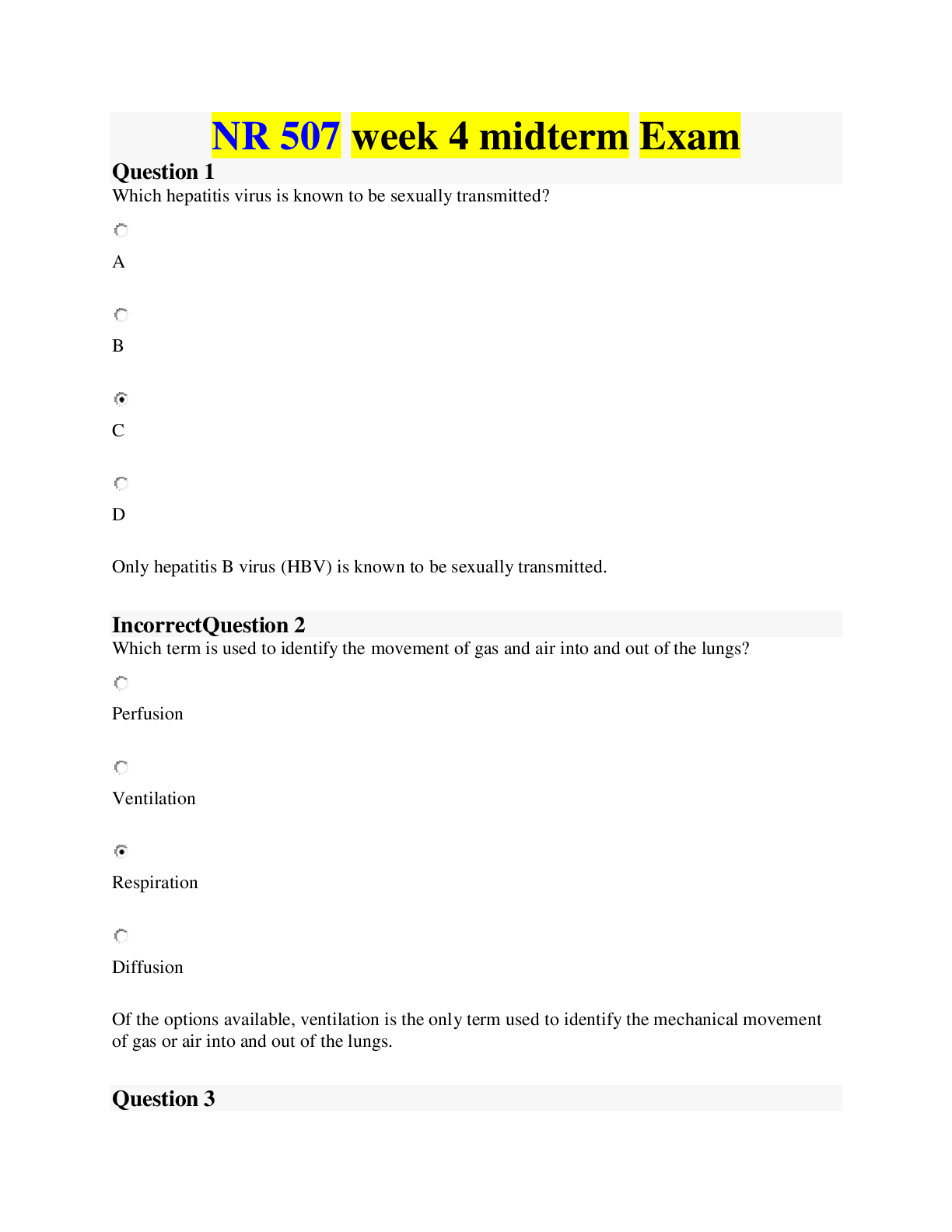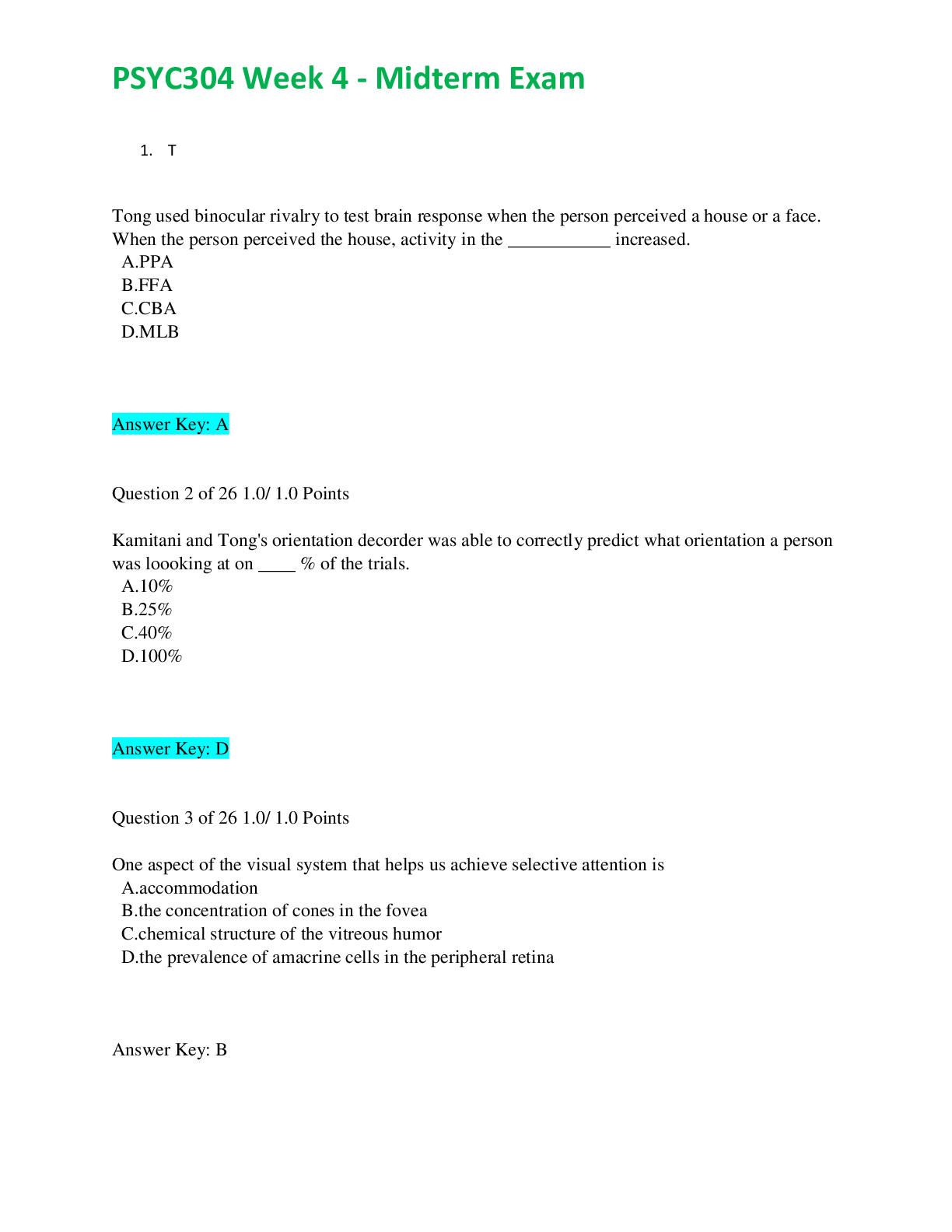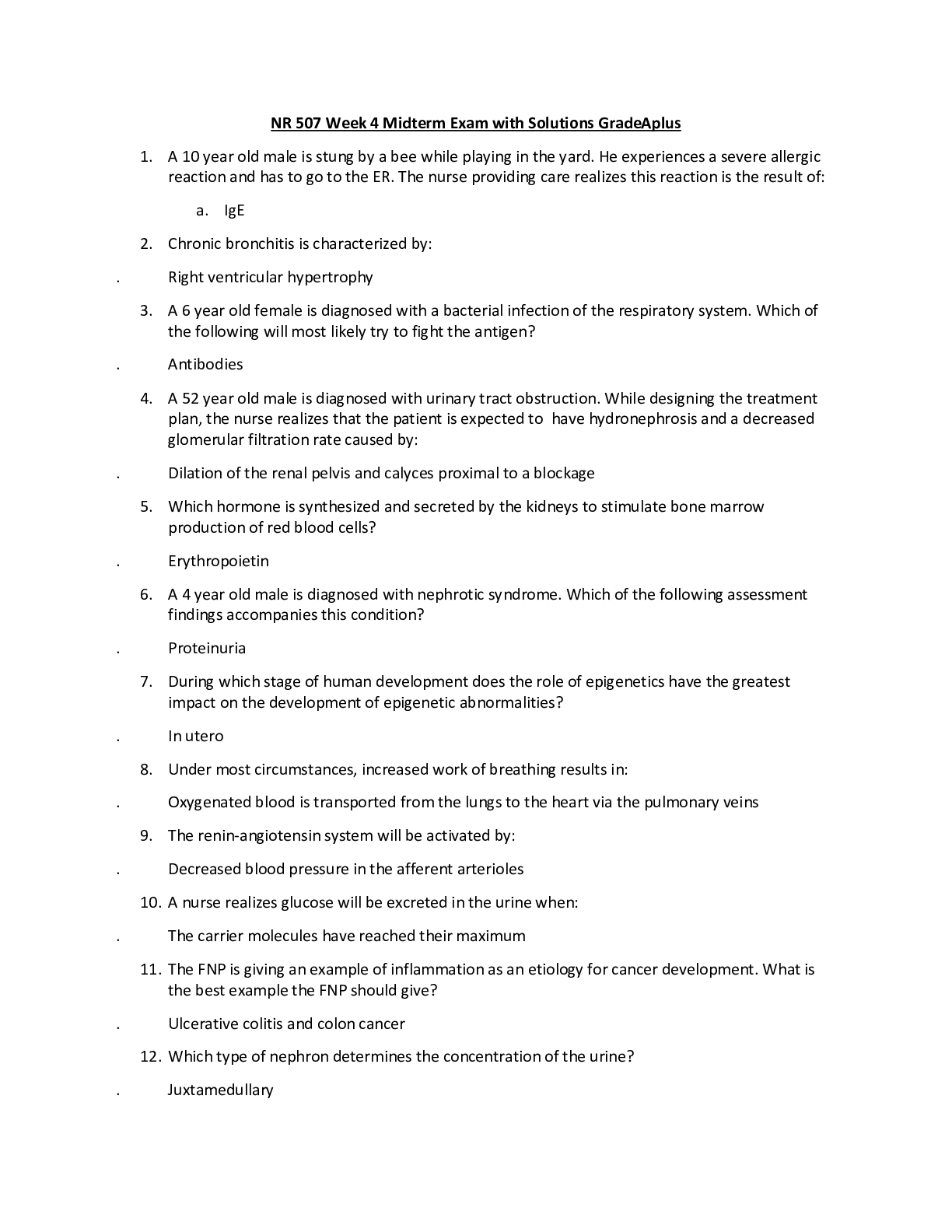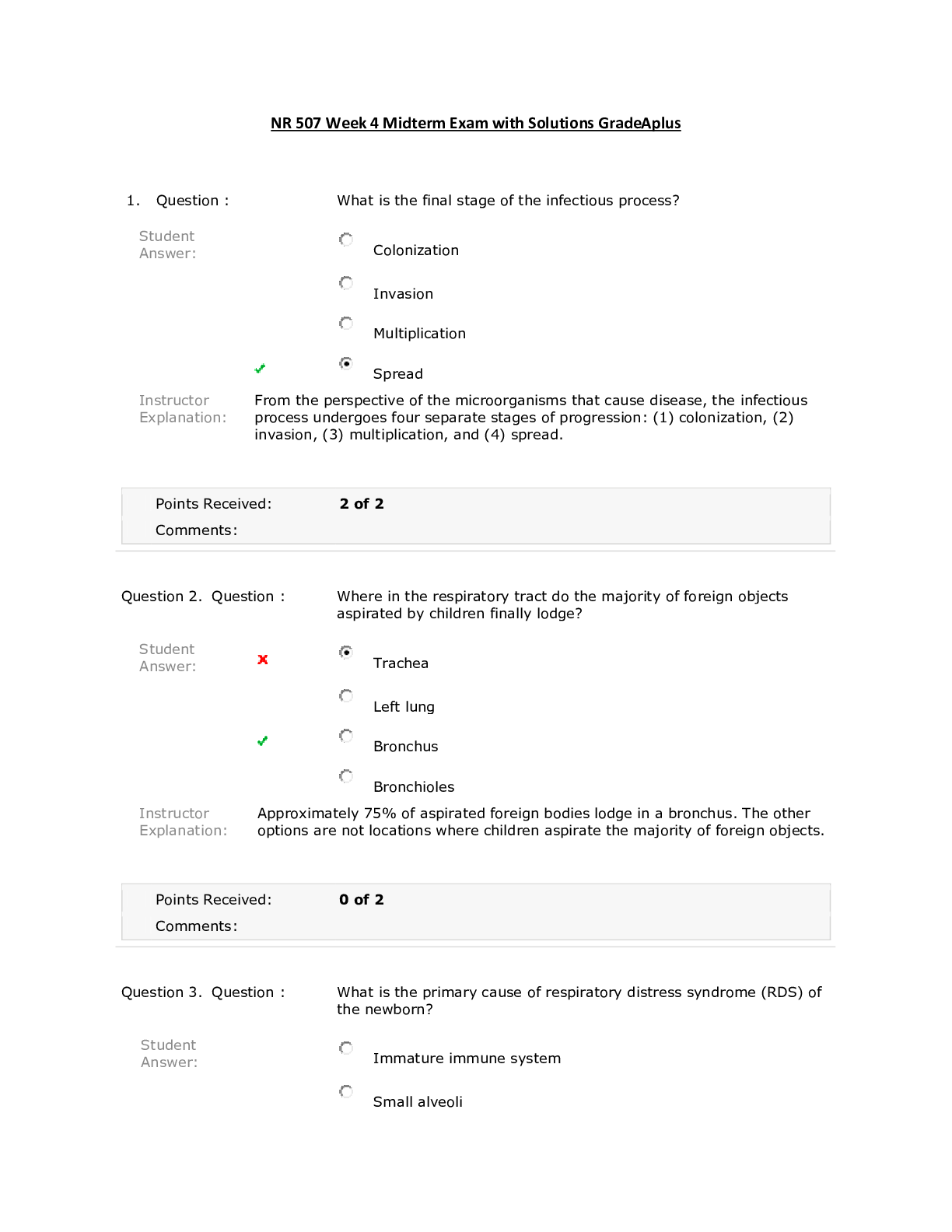NR 601 Week 4 Midterm Study Guide 1 (100 Q and A)
Document Content and Description Below
NR 601 Week 4 Midterm Study Guide 1 (100 Q and A) NR 601 Midterm Study Guide A client is newly diagnosed with type 2 diabetes mellitus. Which diagnostic test will best evaluate the management plan... prescribed for this client? After first managing the pain being experienced by the client with gout, the treatment focuses on: The abrupt onset of symptoms of stress or urge incontinence is most often due to a urinary tract infection A 60-year-old woman presents with a chief complaint of uncomfortable breathing on exertion. She has had a minimally productive cough for several years that does not bother her. On further questioning, she states that her breathing gets much worse when she lies down. The most likely cause of her dyspnea is: Which of the following drugs do not trigger or aggravate a cough? Based on current demographic data, which statement identifies a predictive trend regarding the health care needs of society? Which diagnostic laboratory test would the nurse practitioner typically not order for the purpose of evaluating an individual's acute, unexplained weight loss? It has been projected that the cultural group presenting the greatest growth rate among the older adult population will be the: Which statement made by a client recently diagnosed with diverticular disease would indicate that she needs additional teaching regarding dietary considerations? When diagnosed with diverticulosis, a client asks how this problem occurred. Which assessment data identifies a risk factor for diverticulosis? A 77-year-old client being treated for glaucoma asks the nurse practitioner what causes glaucoma. The nurse bases the response on the knowledge that the increase in intraocular pressure is a result of: Weight loss is frequently caused by ingestion of one or more of the following drugs. Which of the following culturally diverse male clients will most benefit from educational material related to "Staying Healthy into your 80s" The following are true statements about bipolar disorders in older adults except When educating the older adult population about the risks to physical health that chronic alcohol abuse presents, the nurse practitioner is especially careful to include the: Which of the following drugs does not typically cause constipation? An older adult client has been voluntarily admitted for treatment of alcohol dependency. In implementing care, the nurse plans which intervention based upon knowledge about alcohol and aging? The greatest risk for injury for a client with progressed Parkinson's disease is: An older adult client shares with the nurse that, "I don't know what it is but it seems that I need more light for reading or even watching television as I get older." The nurse explains that aging may cause this change due to the: The nurse practitioner educates that client that Healthy People 2010: Which of the following is not a common cause of constipation? The nurse is teaching a health promotion class at a senior center. Which of the following statements demonstrate that the participant does not understand the topic: The nurse practitioner shows an understanding of appropriate influenza vaccination guidelines for a client over the age of 65 when stating: The nurse shows understanding of the need to promote healthy skin in the older adult when encouraging the client to all of the following except : . A 78-year-old man is being evaluated in the geriatric clinic. His daughter reports that he has been very forgetful lately, and she is concerned that he might be "senile." The advanced practice nurse administers the clock drawing test and the patient draws a distorted circular shape and places the numbers all on one side of the shape. Based on his performance, the nurse concludes that the patient: Tinnitus is defined as: Which intervention is not therapeutic when facilitating communication with a cognitively impaired older client? When best promoting a sense of well-being, the role of the nurse practitioner caring for a terminally ill client is to: A 68-year-old male presents with a chief complaint of episodes of lightheadedness or dizziness. He states that sweating, tachycardia, and some hand trembling are often associated with these episodes. Which one of the following questions should you ask to help confirm the diagnosis? The caregiver for an older adult with cognitive impairment is concerned about the individual's seeming disinterest in eating. Which suggestion does the nurse practitioner offer based upon a known effect of dementia on a client's nutrition? A 68-year-old male presents with a chief complaint of episodic dizziness. Although not dizzy at present, he states that he has noted onset of dizzy episodes when he rolls over in bed and occasionally when he turns his head rapidly. Episodes last about 3 minutes. The most likely diagnosis is: What information will be included in client education for an older adult who needs to manage their calcium levels? The nurse practitioner is developing a class on stroke prevention for a local senior citizens center. What would be an important focus when teaching stroke prevention directed at modifiable risk factors? The nurse practitioner provides a client with education regarding the use of My Pyramid. What is the primary advantage of the United States Department of Agriculture's (USDA) An older man has a history of medication therapy for hypertension. Which intervention does the nurse practitioner implement when the client reports that, "I've fallen twice in 5 weeks"? The nurse practitioner is caring for a client with a newly diagnosed chronic illness. In answering the client's questions, the nurse practitioner most accurately responds when basing the response on the fact that: Which statement correctly describes normal changes of aging? An older adult is admitted to the hospital during the night after a serious fall. When you round on the patient, you note that the patient has been prescribed meperidine (Demerol) for muscle pain. The nurse practitioner: Of the following clients, all of whom are 65 years of age or older, the nurse practitioner anticipates that the one who will rate himself or herself as has having excellent health will be: A 75-year old resident in the nursing home has end stage dementia and experiences a 10-pound weight loss over the course of 2 months. The resident has become increasingly difficult to feed and often spits out food, pockets food, and frequently drools. The family is concerned about the resident's nutritional status. What is the initial action of the nurse practitioner? The FANCAPES assessment tool focuses on the older adult's: Which of the following causes of chest pain are often relieved by sublingual nitroglycerin? An older adult is currently prescribed both aspirin (81 mg) and ibuprofen daily. What instructions are most important for the nurse practitioner to provide to assure the expected outcomes for this client? Which assessment data does not support the medical diagnosis of coronary heart disease? What are the 3 primary physiological changes of aging? What is the preferred amount of exercise for elderly? What are PFTs? What is FEV1? What is FVC? What is normal FEV1/FVC ratio? What is GOLD 1 criteria? What is GOLD 2 criteria? What is GOLD 3 criteria? What is GOLD 4 criteria? What are the signal symptoms of COPD? What are characteristics of COPD? What are risk factors for COPD? What is seen on phys exam in COPD? How is COPD diagnosed? How is COPD treated? What is the MOA of beta agonists? What is the MOA of anticholinergics? Why are long-acting beta agonists prescribed for COPD? What are some non pulmonary diagnoses that result in COPD-type symptoms? What are some Hyperventilation syndrome What are signal symptoms of asthma? What is chronic bronchitis? Usually worse on wakening. What is emphysema? Chronic inflammation/remodeling, trapping air, hindering effective O2/CO2 exchange (all due to inflammatory mediators infiltrating airways). What are signal symptoms of ischemic heart dz? What is ischemic heart dz? What are signal symptoms of lung CA? What is lung CA? What are signal symptoms of MI? What is an MI? What are signal symptoms of pneumonia? What is community acquired pneumonia? What are signal symptoms of a PE? What is PE description? What are signal symptoms of tuberculosis? What is tuberculosis? What are signal symptoms of valvular heart dz? What is valvular heart dz? Most prevalent types in elderly: calcific and degenerative aortic valve dz What is aortic regurgitation? What is mitral stenosis? What is mitral regurgitation? What is mitral valve prolapse? What are most common causes of VHD in elderly? What happens in valvular regurgitation? What happens in valvular stenosis? What are signal symptoms of URI? What is a URI? What are signal symptoms of restrictive lung dz? What is restrictive lung dz? What is the purpose of functional assessment of the elderly? What can ongoing pain be linked to in the elderly? Is chronic pain a normal sign of aging? What is polypharmacy? What is Stage A of HF? What is Stage B HF? What is Stage C HF? What is Stage D HF? What are treatment goals for Stage A HF? What are drugs used in Stage A HF? What are treatment goals for Stage B HF? What are drugs used in Stage B HF? In selected pt's: What are goals of Stage C HFpEF? What is treatment for Stage C HFpEF? What are treatment goals for Stage C HFrEF? What are drugs used in Stage C HFrEF? Drugs in selected pts: Procedures in selected pts: What are treatment goals in Stage D HF? What are options for Stage D HF? What is the normal BNP level? What is normal BP? What is "elevated" BP? What is Stage 1 HTN? What is Stage 2 HTN? What is recommended BP for DM? What is recommended BP for CKD? How should HTN be managed? What is first-line meds for non-black HTN population (including those w/DM)? What is the med guideline for ASCVD for those </= 75yo? What is the med guideline for ASCVD for those >75yo? What is the guideline for meds for LDL >/= 190? What is the med guideline for ASCVD for 40-75yo w/DM? What is the med guideline for LDL 70-189? What is the ASCVD med guideline for 40-75yo w/out ASCVD or DM? What is the purpose for Beers criteria? What are potential risk factors for ADRs in elderly? What are some 2015 changes in med awareness for elderly? Opioids should be avoided in those with h/o falls/fractures. The meds listed in Beers Criteria are not absolutely contraindicated in elderly. The BC recommendations are graded as high, medium, low to assist w/decision making. The BC list includes dosage adjustments for kidney impairment. The BC list includes drug to drug interactions to avoid. Responsible prescribing is an important role of NP and BC can assist in determining the safest meds for geri pts. What vaccination is recommended for people traveling to countries where dz is common? How is Hep A vax given? When is Hep B vax recommended? How is Hep B vax given? When is Zostavax recommended? Can people who have had prior episode of zoster be vaccinated? When is flu vax recommended? When is pneumococcal vax recommended? What is primary prevention? Health counseling and immunizations are examples. What is secondary prevention? What is tertiary prevention? What are common s/s of anxiety in elderly? What are phobic disorders? What is generalized anxiety disorder (GAD)? What is PTSD? What is panic disorder? What is agoraphobia? What is OCD? What is treatment for anxiety? What are signal symptoms of depression? The symptoms of depression may encompass what 4 domains? What is treatment goal for depression? What are first-line meds for depression? What is transient insomnia? What is short-term insomnia? What is chronic insomnia? What is treatment for insomnia? What are signal symptoms of polymyalgia rheumatica? What are common lab findings in polymyalgia rheumatica? What is treatment for PMR? What are signal symptoms of rheumatoid arthritis? What are diagnostic tests for RA? Erosive dz and raised RF indicate seropositive RA What is treatment for RA? What are diagnostic tests for OA? What is treatment for OA? What is the major difference between varicose veins and atherosclerosis? 43yo hispanic male has audible diastolic murmur best heard at the mitral point. No audible click. He has been monitored for 2yrs. What is the most likely murmur? What is osteoporosis? What are diagnostic tests for osteoporosis? What is T-score of -2.5 or lower indicative of? What is a T-score of -1.0 to -2.5 indicative of? What is a T-score of -1.0 or higher indicative of? What is a Z-score of <-1.5 indicative of? What are the risk factors for osteoporosis? What is the treatment for osteoporosis? How does chronic pain differ from acute pain? What is the principle goal of chronic pain treatment? What is nociceptive pain? What is neuropathic pain? What are treatments for nociceptive pain? What are treatments for neuropathic pain? The percentage of the FVC expired in one second is: The aging process causes what normal physiological changes in the heart? A 55yo Caucasian male follows up after referral to cardiologist. He thinks his med is causing a cough and sometimes he has difficulty breathing. Which med was most likely prescribed? JM is a 68yo man who presents for a physical. He has T2DM x5yrs, smokes 1/2 PPD, BMI is 30. No other previous medical dx, no current complaints. According to the AHA/ACC guidelines, JM is stage A HF. Treatment goals for him include: MJ presents with h/o structural damage with current s/s of HF. Treatment will be based on his stage of HF, which is: 65yo Caucasian female presents with mitral valve stenosis, physical exam unremarkable. You know her stage of HF is: DG, 65yo man, presents for eval of CP and L-sided shoulder pain, beginning after strenuous activity, including walking. Pain is dull, aching, 8/10 during activity, otherwise 0/10. Began few mo ago, intermittent, aggravated by exercise, relieved by rest. Occasional nausea. Pain is retrosternal, radiating to L shoulder, affects QOL by limiting activity. Pain is worse today, did not go away after stopped walking. BP 120/80, HR 72 and regular. Normal heart sounds, no murmur, S1, S2. Which differential dx would be most likely? The best way to dx structural heart dz/dysfunction non-invasively is: Chronic pain can have major impact on pt's ability to function and have profound impact on overall QOL. Ongoing pain may be linked to: The Beers criteria are appropriate for use in evaluating use of certain meds in pts: Pt presents with c/o increasing SOB, cough w/occasional white sputum, fatigue. As part of the plan you order labs. You know the likelihood of HF is low if the BNP is: All of the following statements are true about lab values in older adults except: According to the 2017 ACC HTN guidelines, the recommended BP goal for a 65yo African American woman w/a h/o HTN and DM and no h/o CKD is: The pathophysiology of HF is due to: A 60yo woman w/30 pack yr hx, presents for eval of persistent, daily cough w/increased sputum, worse in the AM, occurring over past 3 months. She tells you, "I have the same thing year after year." Which of the following choices would you consider strongly in your critical thinking process? JM is a 68yo man who presents for a physical. He has T2DM x5yrs, diet controlled. His BMI is 32. He has HTN, smoker (10 cigs/day x20yrs). He denies other medical problems. Fam hx includes CAD, CABG x4 for dad, now deceased; CHF, T2DM, HTN for mom. He is asymptomatic today, exam is normal, EKG NSR. According to AHA/ACC guidelines, JM is at risk for what stage of HF? The volume of air a pt is able to exhale for total duration of the test during maximal effort is: According to the 2017 ACC HTN guidelines, normal BP is: Functional abilities are best assessed by: LB is a 77yo pt w/chronic poorly controlled HTN. You know that goals include prevention of target organ damage. During your eval you will assess for evidence of: Aortic regurgitation requires medical treatment for early signs of HF with: The volume of air in the lungs at max inflation is: Preferred amount of exercise for older adults is: The total volume of air a pt is able to exhale in the first second during max effort is: You know the following statements regarding the pain of acute coronary syndrome are true except: Elderly pt presents w/new onset of feeling heart race, fatigue. EKG reveals afib w/rate >100. Pt also has a new tremor in both hands. Which of the following would you suspect? 62yo female c/o fatigue, lack of energy. Constipation increased, pt gained 10lbs in past 3mo. Depression is denied although pt reports lack of interest in usual hobbies. VS are WNL, skin is dry/cool. Which of the following must be included in the DD? Mrs. Black, 87yo, has been taking 100mcg Synthroid x10yrs. She comes for routine follow-up, feeling well. HR is 90. Your first response is to:& [Show More]
Last updated: 1 year ago
Preview 1 out of 36 pages
Instant download
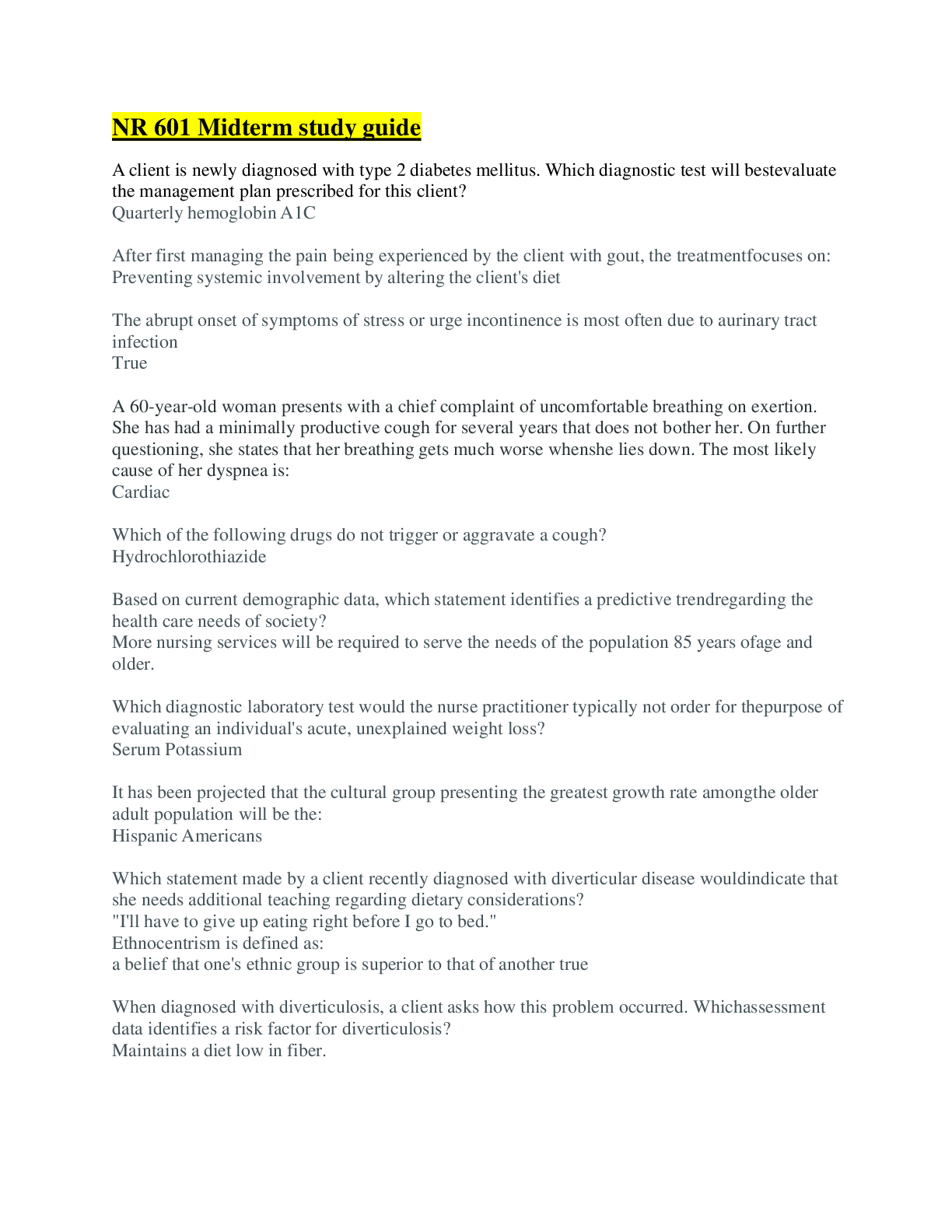
Buy this document to get the full access instantly
Instant Download Access after purchase
Add to cartInstant download
Reviews( 0 )
Document information
Connected school, study & course
About the document
Uploaded On
Jul 12, 2021
Number of pages
36
Written in
Additional information
This document has been written for:
Uploaded
Jul 12, 2021
Downloads
0
Views
47


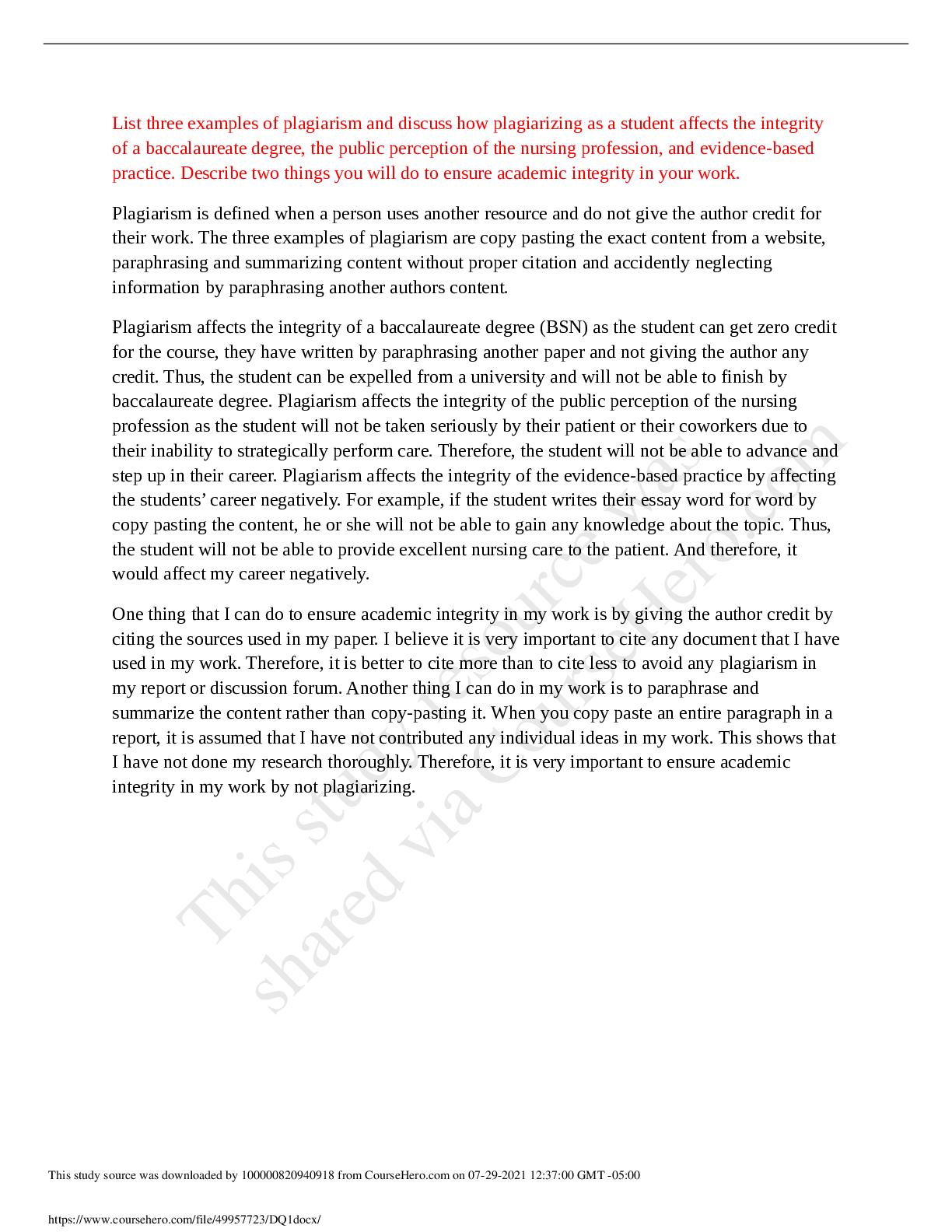

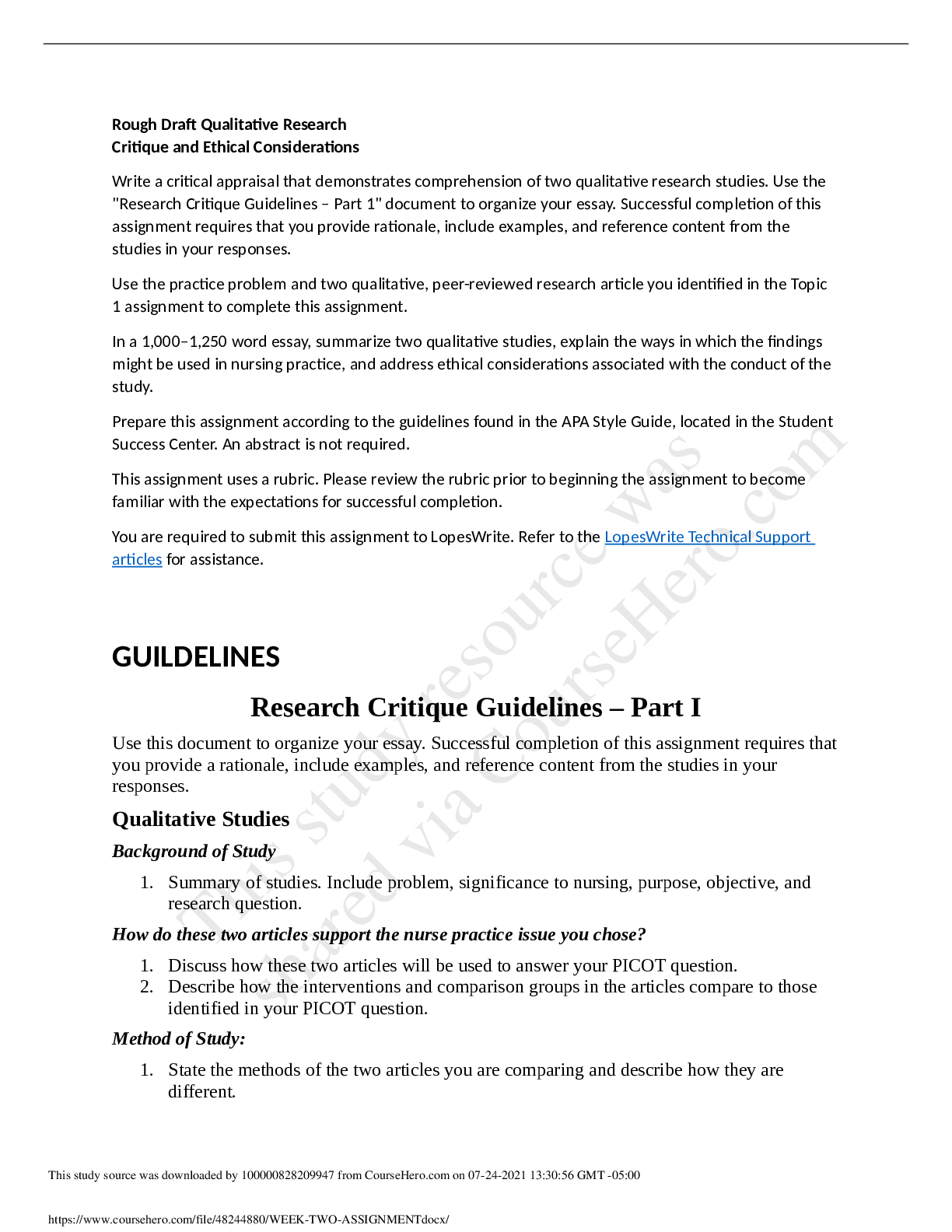



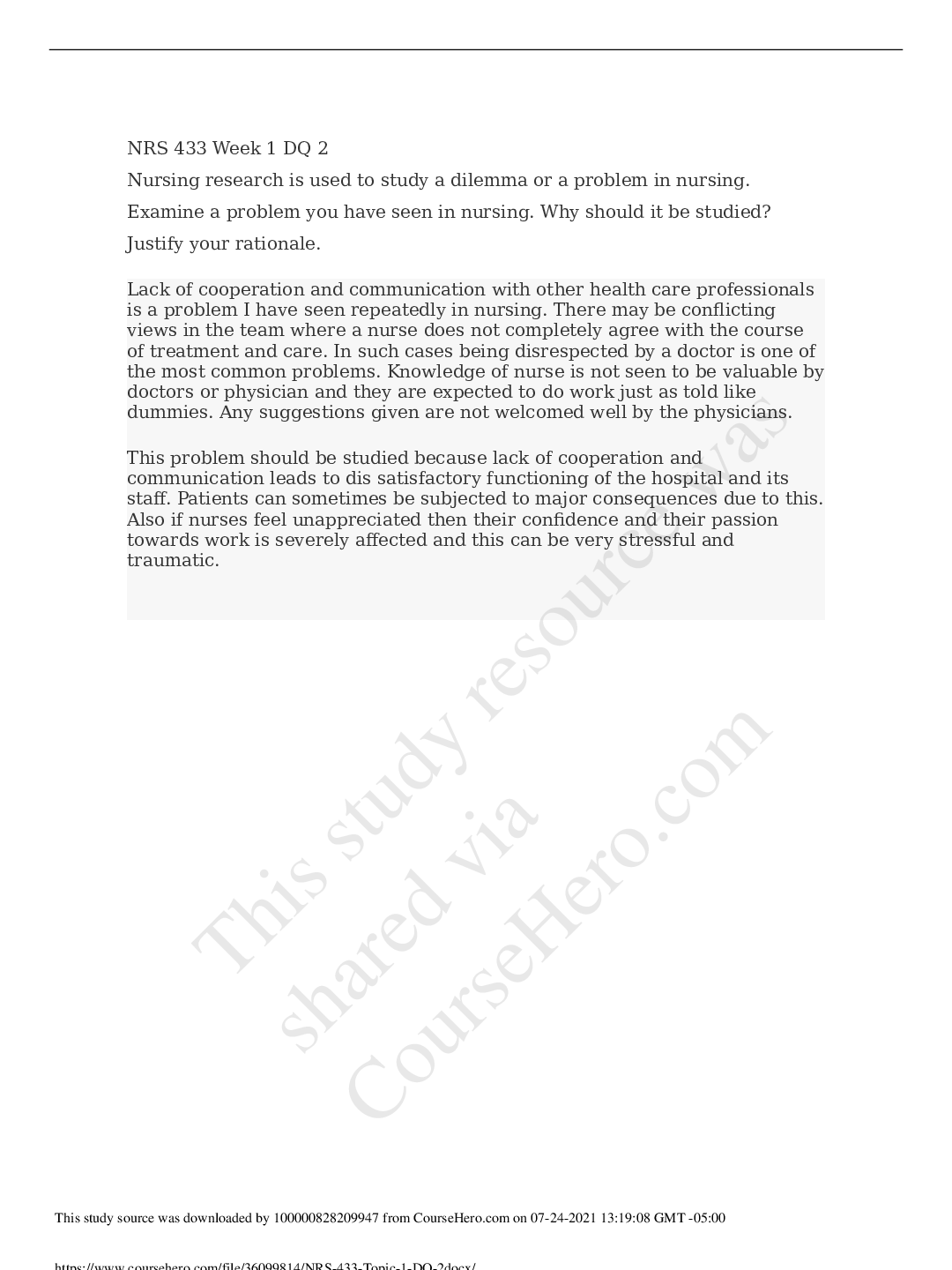

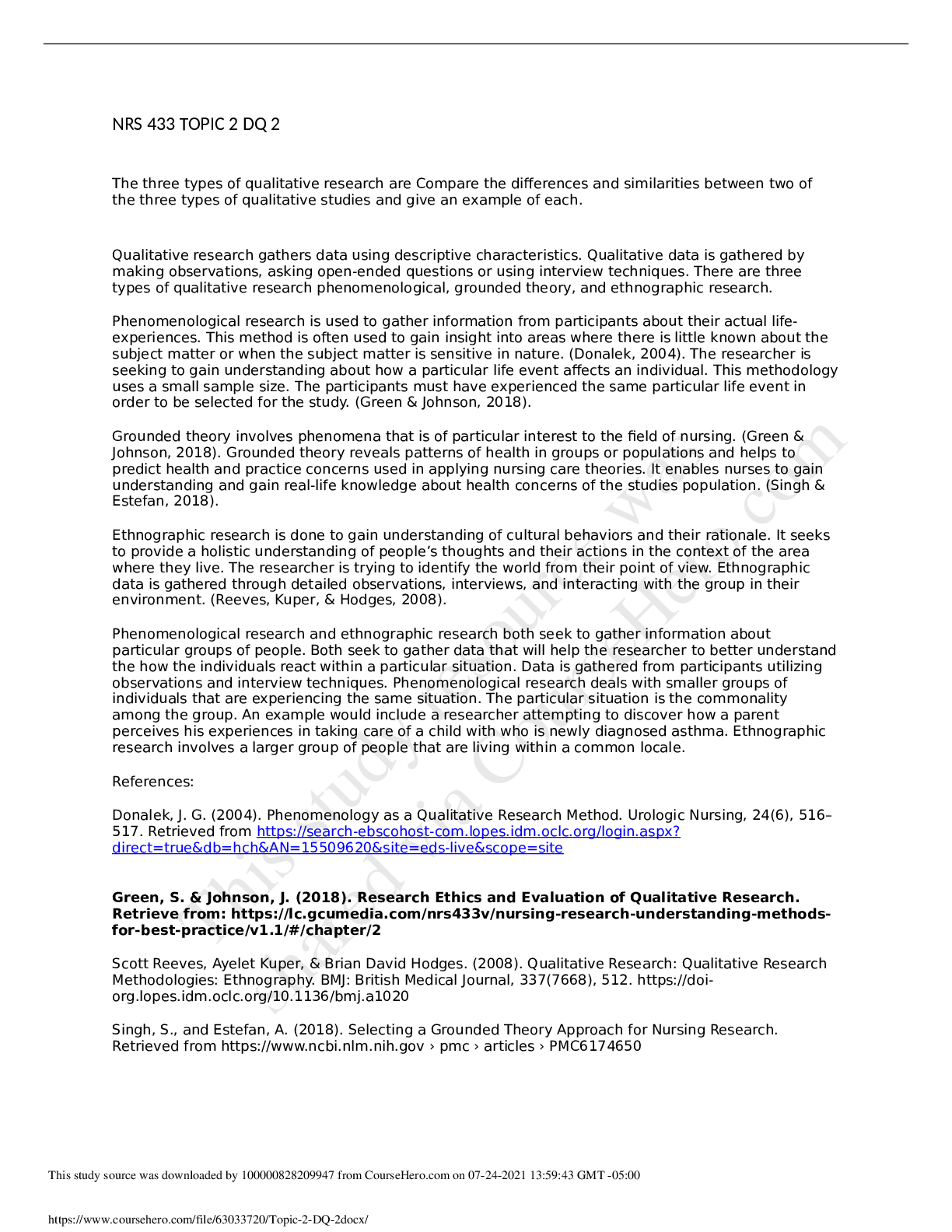
.png)


